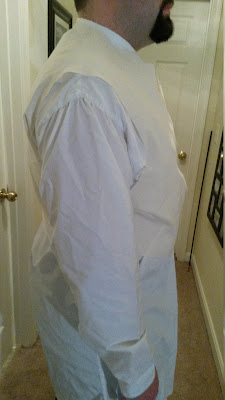Below are pictures of that initial fit, which was rather lacking to say the least particularly at the shoulders. of the muslin over a period shirt. There is also a lot of diagonal wrinkling from the shoulders down to the bottom center forepart. (I was also unable to pin the vest straight) The last image shows a lot of wrinkling under the arm, when it is raise due to the interference of the far too long shoulder seam with the ball of shoulder; this is due to the fact that the drafts made with Devere aren't graded like modern patterns and are entirely based on the chest size. Because I am "portly" my shoulders are much smaller then my chest when compared to Devere's Proportionate man.
Also I apologize for the poor quality images, seem cell phone camera have a hard time focusing on white against, a white background.
Also I apologize for the poor quality images, seem cell phone camera have a hard time focusing on white against, a white background.
At the suggestion of Mr. Ruley on "The Sewing Academy" forum [1], I made another draft of the forepart in which the bust was calculated against to measured curve. I took the measured curve and added 2 1/2 graduated inches to it, to come up with the calculated bust based on the proportionate man. And straight from Devere:
FOREPART.So below are some images of the new forepart with the old back. The fit is much improved, although as can be seen in the raised arm photograph; the issues of interference with the ball of shoulder are still present. I suspect much relief will need to be taken to reduce the shoulder-seam and enlarge the armscye.
The first point we have to notice is, that the full length is 19 3/4; that is, equal to the length of back 17 1/4, plus the distance to the top of back from the corner of the square, (2 1/2).










